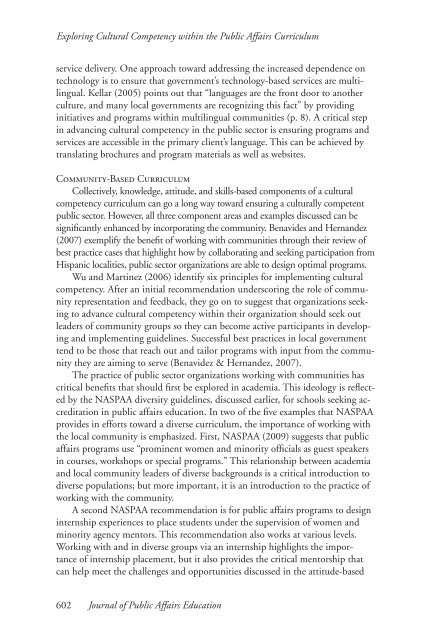Exploring Cultural Competency Within the Public Affairs Curriculum
Exploring Cultural Competency Within the Public Affairs Curriculum
Exploring Cultural Competency Within the Public Affairs Curriculum
Create successful ePaper yourself
Turn your PDF publications into a flip-book with our unique Google optimized e-Paper software.
<strong>Exploring</strong> <strong>Cultural</strong> <strong>Competency</strong> within <strong>the</strong> <strong>Public</strong> <strong>Affairs</strong> <strong>Curriculum</strong><br />
service delivery. One approach toward addressing <strong>the</strong> increased dependence on<br />
technology is to ensure that government’s technology-based services are multilingual.<br />
Kellar (2005) points out that “languages are <strong>the</strong> front door to ano<strong>the</strong>r<br />
culture, and many local governments are recognizing this fact” by providing<br />
initiatives and programs within multilingual communities (p. 8). A critical step<br />
in advancing cultural competency in <strong>the</strong> public sector is ensuring programs and<br />
services are accessible in <strong>the</strong> primary client’s language. This can be achieved by<br />
translating brochures and program materials as well as websites.<br />
Community-Based <strong>Curriculum</strong><br />
Collectively, knowledge, attitude, and skills-based components of a cultural<br />
competency curriculum can go a long way toward ensuring a culturally competent<br />
public sector. However, all three component areas and examples discussed can be<br />
significantly enhanced by incorporating <strong>the</strong> community. Benavides and Hernandez<br />
(2007) exemplify <strong>the</strong> benefit of working with communities through <strong>the</strong>ir review of<br />
best practice cases that highlight how by collaborating and seeking participation from<br />
Hispanic localities, public sector organizations are able to design optimal programs.<br />
Wu and Martinez (2006) identify six principles for implementing cultural<br />
competency. After an initial recommendation underscoring <strong>the</strong> role of community<br />
representation and feedback, <strong>the</strong>y go on to suggest that organizations seeking<br />
to advance cultural competency within <strong>the</strong>ir organization should seek out<br />
leaders of community groups so <strong>the</strong>y can become active participants in developing<br />
and implementing guidelines. Successful best practices in local government<br />
tend to be those that reach out and tailor programs with input from <strong>the</strong> community<br />
<strong>the</strong>y are aiming to serve (Benavidez & Hernandez, 2007).<br />
The practice of public sector organizations working with communities has<br />
critical benefits that should first be explored in academia. This ideology is reflected<br />
by <strong>the</strong> NASPAA diversity guidelines, discussed earlier, for schools seeking accreditation<br />
in public affairs education. In two of <strong>the</strong> five examples that NASPAA<br />
provides in efforts toward a diverse curriculum, <strong>the</strong> importance of working with<br />
<strong>the</strong> local community is emphasized. First, NASPAA (2009) suggests that public<br />
affairs programs use “prominent women and minority officials as guest speakers<br />
in courses, workshops or special programs.” This relationship between academia<br />
and local community leaders of diverse backgrounds is a critical introduction to<br />
diverse populations; but more important, it is an introduction to <strong>the</strong> practice of<br />
working with <strong>the</strong> community.<br />
A second NASPAA recommendation is for public affairs programs to design<br />
internship experiences to place students under <strong>the</strong> supervision of women and<br />
minority agency mentors. This recommendation also works at various levels.<br />
Working with and in diverse groups via an internship highlights <strong>the</strong> importance<br />
of internship placement, but it also provides <strong>the</strong> critical mentorship that<br />
can help meet <strong>the</strong> challenges and opportunities discussed in <strong>the</strong> attitude-based<br />
602 Journal of <strong>Public</strong> <strong>Affairs</strong> Education

















